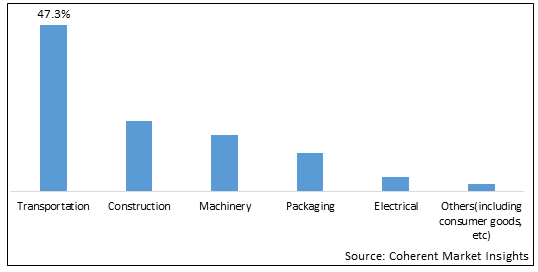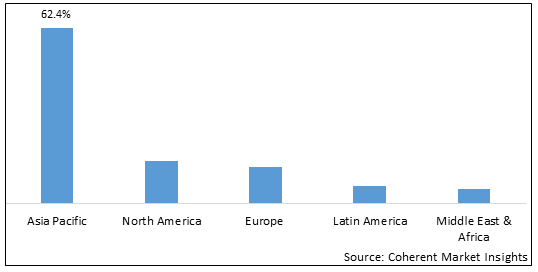Aluminum Alloys Market is estimated to be valued at USD 167.34 Bn in 2025 and is expected to reach USD 253.28 Bn in 2032, exhibiting a compound annual growth rate (CAGR) of 6.1% from 2025 to 2032. Aluminum is one of the popular metal that is widely used across various industries such as transportation, and electronics. In aluminum alloys, alloying metal is added with the base metal aluminum, in order to enhance the properties of pure aluminum and make it suitable for a wide range of applications.
Global Aluminum Alloys Market - Impact of Coronavirus (COVID-19) Pandemic
The COVID-19 pandemic had a substantial negative impact on the global aluminum alloys market. During the COVID-19 outbreak, the aluminum alloys market sustained a significant loss as manufacturing in the automotive and aerospace industries halted, and only the medical supply and life-support sectors were permitted to operate. The increase in demand from various industries, including buildings and construction, machinery, and marine, was reduced to a certain extent.
Global Aluminum Alloys Market: Growth Drivers
Growing Automotive Industry
Growing automotive industry is expected to drive the market growth. The automotive industry is one of the largest consumers of aluminum alloys. Growing production of automobiles around the globe increases consumption of these alloys, and this is expected to drive the market growth. For instance, in 2022, according to the European Automobile Manufacturers Association, 10.9 million passenger cars were manufactured in the European Union, indicating increase of 8.3%, as compared to 2021.
Increasing Cargo Transportation
Increasing cargo transportation boosts marine industry growth. Metal such as aluminum is widely used in the shipbuilding industry to reduce the overall weight of the ship without compromising on strength of the ship. Moreover, aluminum alloys are highly resistant to corrosion compared to other metal, and this boosts demand for aluminum alloys in the shipbuilding industry. For instance, United Nations Conference on Trade and Development UNCTAD projects global maritime trade will lose steam, with growth slowing to 1.4% in 2022. For the period 2023–2027, it is expected to grow at 2.1% annually – slower than the 3.3% average recorded during the past three decades.
Global Aluminum Alloys Market: Restraints
Environmental Regulations
Environmental concerns such as increasing pollution and growing energy costs are compelling government to implement strict rules and regulations for the production of aluminum alloys. This factor is expected to hinder the market growth over the forecast period. However, aluminum industry are taking initiatives to address these concerns. There is growing trend towards adoption of sustainable practices such as recycling aluminum and reducing greenhouse gas emissions. This helps to alleviate the environmental impact of aluminum production, and maintain its market growth. Energy efficiency research and development (R&D) will further reduce the industry’s exposure to rising energy costs. Overall, to overcome these challenges, the aluminum industry is actively working towards finding solutions.
High Cost of Fabrication Process
Expensive fabrication process coupled with availability of the other low-cost substitute products is expected to restrict the adoption of aluminum alloys. Steel is one of the common substitutes that is widely used across various industries instead of aluminum. This factor is expected to restrict the market growth. Despite the challenges posed by the expensive fabrication process and the availability of low-cost substitute products, the market for aluminum alloys can find its counterbalance through several factors.
Market Trends
Increasing use of the aluminum alloy in the production of an electronic component
Increasing use of the aluminum alloy in the production of an electronic component is augmenting the market growth. Increasing demand for portable electronic devices such as tablets, smartphones, and wearable devices is a growing trend in the market. These gadgets are gaining huge demand especially from teenagers and the adult population. Moreover, changing lifestyles and increasing purchasing power of the consumers is further driving demand for such gadgets, which in turn, propelling the market growth of the aluminum alloys.
Aluminum Alloys Market Report Coverage
| Report Coverage | Details | ||
|---|---|---|---|
| Base Year: | 2024 | Market Size in 2025: | USD 167.34 Bn |
| Historical Data for: | 2020 To 2024 | Forecast Period: | 2025 To 2032 |
| Forecast Period 2025 to 2032 CAGR: | 6.1% | 2032 Value Projection: | USD 253.28 Bn |
| Geographies covered: |
|
||
| Segments covered: |
|
||
| Companies covered: |
United Company RUSAL Plc, Alcoa Inc., Aluminum Corp. of China Ltd., Kaiser Aluminum Corporation, Norsk Hydro ASA, Dubai Aluminum Co., Constellium, Kobe Steel, Ltd., and Aluminum Bahrain B.S.C. |
||
| Growth Drivers: |
|
||
| Restraints & Challenges: |
|
||
Uncover macros and micros vetted on 75+ parameters: Get instant access to report
Global Aluminum Alloys Market: Market Segmentation
On the basis of end user, transportation segment dominated the global aluminum alloys market in 2025 with around 47.3% of the market share, followed by construction, packaging, machinery, electrical, and others(including consumer goods) respectively. The transportation industry became the biggest end user of aluminum alloys in 2025, dominating the market with a sizeable 47.3% market share, in terms of market value due to rising usage of aluminum alloys in the automotive sector to create lightweight, fuel-efficient vehicles. The next largest industry after transportation was construction that used aluminum alloys for its superior strength-to-weight ratio in building structures. Electrical machinery and packaging industries also contributed to the market share, showing that aluminum alloys are versatile and widely used. Aluminum alloys were also used by other sectors such as consumer goods, in a variety of applications.
Figure 1: Global Aluminum Alloys Market Value Share (%), By End User, 2025

To learn more about this report, Request sample copy
Global Aluminum Alloys Market: Regional Analysis
Asia Pacific held a dominant position in the market in 2025 accounting for 62.4% market value share over the forecast period followed by North America and Europe. Asia Pacific region is currently the largest and fastest-growing market for aluminum alloys worldwide due to the presence of major aluminum manufacturers in the region and huge demand from various end-use industries. China specifically plays a significant role in driving growth of the Asia Pacific market as the largest consumer and producer of aluminum alloys. Moreover, the region is witnessing significant investments in industries such as infrastructure, automotive, and aerospace that further boosts demand for aluminum alloys. North America is the second-largest market for aluminum alloys due to huge demand for alloys from the automotive and construction sectors. The region is known for its advanced manufacturing capabilities and technological advancements that contribute to the market growth. Europe also holds a significant market share in the global aluminum alloys market due to the presence of major automotive manufacturers. Furthermore, the region's strict environmental regulations promotes the use of lightweight materials like aluminum alloys in the automotive industry. Latin America is experiencing a steady growth rate in the aluminum alloys market due to expanding construction and transportation sectors. Middle East and Africa region have untapped potential in the aluminum alloys market, with increasing infrastructure investments. Overall, these factors contribute to the growth and significance of the aluminum alloys market across different regions.
Figure 2: Global Aluminum Alloys Market Value Share (%), By Region, 2025

To learn more about this report, Request sample copy
Global Aluminum Alloys Market: Recent Developments
Global Aluminum Alloys Market: Key Companies
Major players operating in the global aluminum alloys market include United Company RUSAL Plc, Alcoa Inc., and Aluminum Corp. of China Ltd., Kaiser Aluminum Corporation, Norsk Hydro ASA, Dubai Aluminum Co., Constellium, Kobe Steel, Ltd., and Aluminum Bahrain B.S.C.
*Definition: Aluminum alloys are metallic materials that consist primarily of aluminum. These are created by combining aluminum with one or more alloys to improve its mechanical and physical properties. These alloys may contain copper, silicon, magnesium, zinc, and manganese. Aluminum alloys are known for their lightweight nature, high strength-to-weight ratio, and excellent corrosion resistance. These are widely used in various industries such as aerospace, automotive, construction, and packaging.
Share
Share
About Author
Yash Doshi is a Senior Management Consultant. He has 12+ years of experience in conducting research and handling consulting projects across verticals in APAC, EMEA, and the Americas.
He brings strong acumen in helping chemical companies navigate complex challenges and identify growth opportunities. He has deep expertise across the chemicals value chain, including commodity, specialty and fine chemicals, plastics and polymers, and petrochemicals. Yash is a sought-after speaker at industry conferences and contributes to various publications on topics related commodity, specialty and fine chemicals, plastics and polymers, and petrochemicals.
Missing comfort of reading report in your local language? Find your preferred language :
Transform your Strategy with Exclusive Trending Reports :
Frequently Asked Questions
Select a License Type
Credibility and Certifications

860519526

9001:2015
27001:2022


Joining thousands of companies around the world committed to making the Excellent Business Solutions.
View All Our Clients
US Reciprocal Tax Impact Analysis On Aluminum Alloys Market
Stay updated on tariff changes with expert insights and timely information